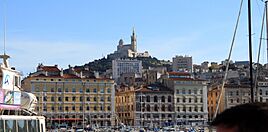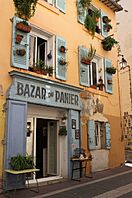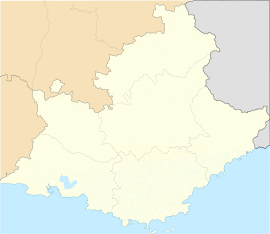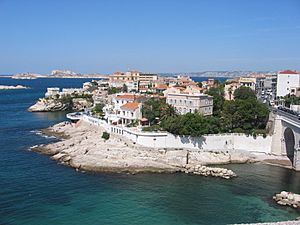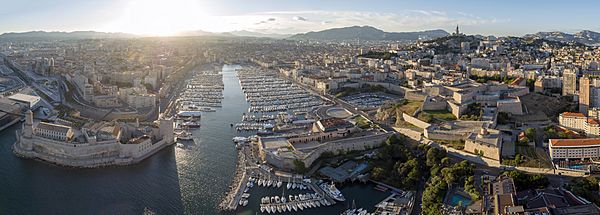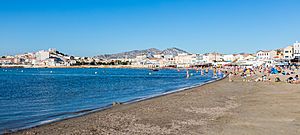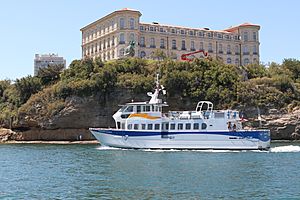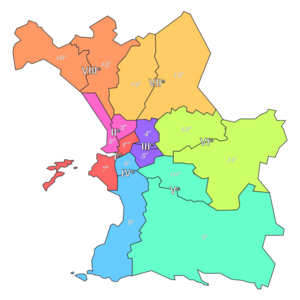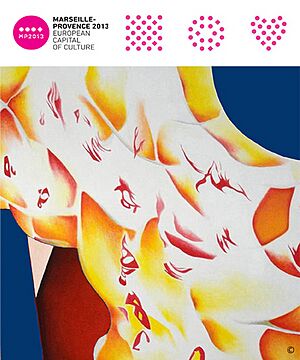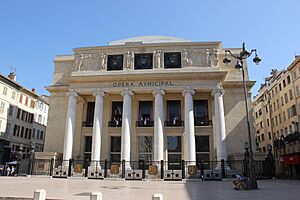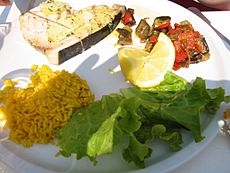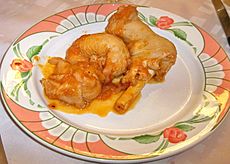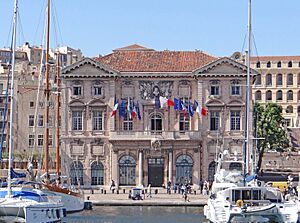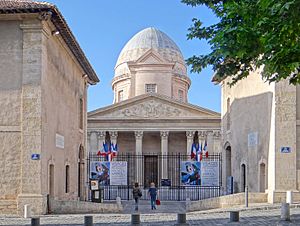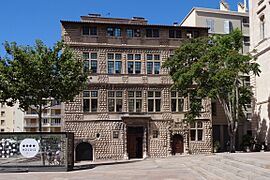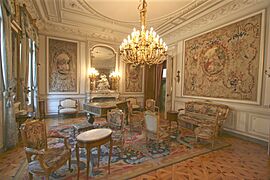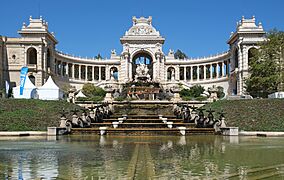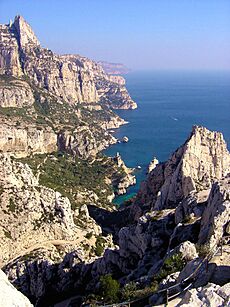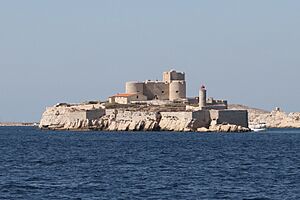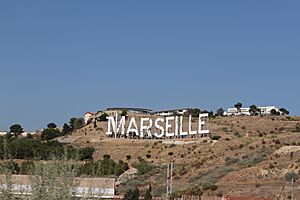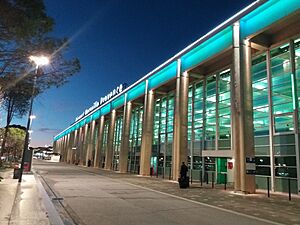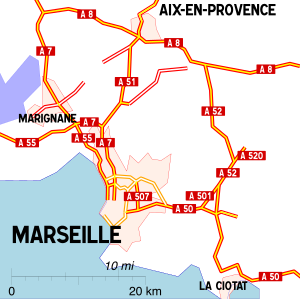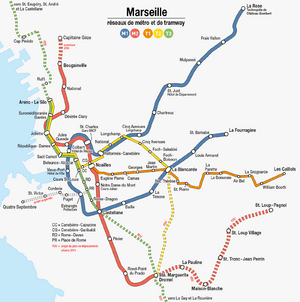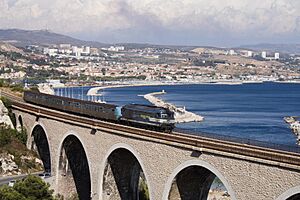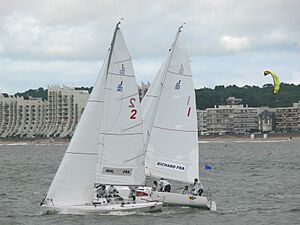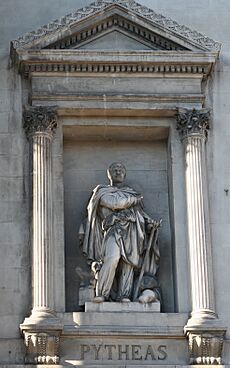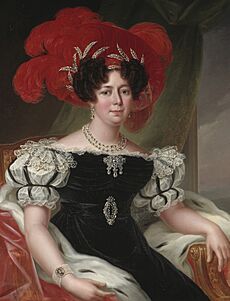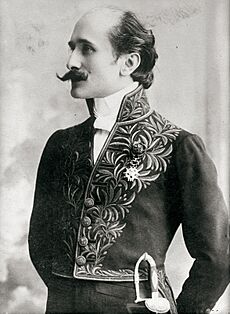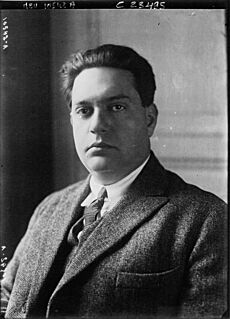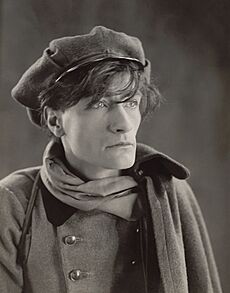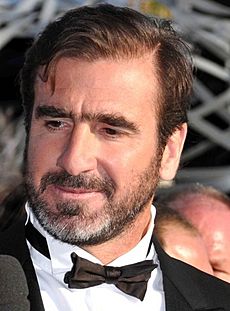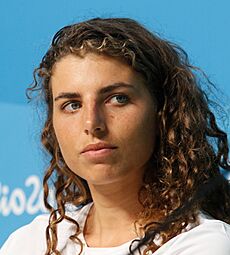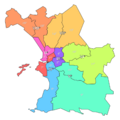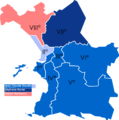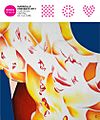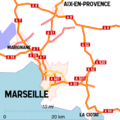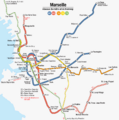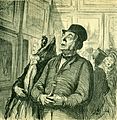Marseille facts for kids
Quick facts for kids
Marseille
Marselha (Occitan)
|
|||
|---|---|---|---|
|
Prefecture and commune
|
|||
|
Old Port and Notre-Dame de la Garde
narrow streets near Fort Saint-Jean
Calanque d'En-Vau in Calanques National Park
view of the Frioul archipelago from the city
Palais Longchamp
Marseille Cathedral
|
|||
|
|||
| Motto(s):
Actibus immensis urbs fulget massiliensis
"The city of Marseille shines from its great achievements" |
|||
| Country | France | ||
| Region | Provence-Alpes-Côte d'Azur | ||
| Department | Bouches-du-Rhône | ||
| Arrondissement | Marseille | ||
| Canton | 12 cantons | ||
| Intercommunality | Aix-Marseille-Provence Metropolis | ||
| Subdivisions | 16 arrondissements | ||
| Area
1
|
240.62 km2 (92.90 sq mi) | ||
| • Urban
(2020)
|
1,758.2 km2 (678.8 sq mi) | ||
| • Metro
(2020)
|
3,971.8 km2 (1,533.5 sq mi) | ||
| Population
(2021)
|
873,076 | ||
| • Rank | 2nd in France | ||
| • Density | 3,628.44/km2 (9,397.62/sq mi) | ||
| • Urban
(Jan. 2021)
|
1,625,845 | ||
| • Urban density | 924.721/km2 (2,395.02/sq mi) | ||
| • Metro
(Jan. 2021)
|
1,888,788 | ||
| • Metro density | 475.550/km2 (1,231.668/sq mi) | ||
| Demonym(s) | Marseillais (French) Marselhés (Occitan) Massiliot (ancient) |
||
| Time zone | UTC+01:00 (CET) | ||
| • Summer (DST) | UTC+02:00 (CEST) | ||
| INSEE/Postal code |
13055 /13001-13016
|
||
| Dialling codes | 0491 or 0496 | ||
| 1 French Land Register data, which excludes lakes, ponds, glaciers > 1 km2 (0.386 sq mi or 247 acres) and river estuaries. | |||
Marseille is a large city in southern France. It is located right on the coast of the Mediterranean Sea. Marseille is the second most populated city in France. In 2021, about 873,000 people lived there. The larger area around Marseille, including its suburbs, has over 1.8 million people.
Marseille is the oldest city in France. It was started around 600 BC by Greek settlers. Back then, it was known as Massalia. It has always been an important trading port. The city grew a lot in the 1800s, becoming a busy industrial and trading center.
Today, the Old Port is still at the heart of the city. This is where Marseille soap was first made hundreds of years ago. Overlooking the port is the Basilica of Notre-Dame-de-la-Garde. People in Marseille call it "Bonne-mère," which means "Good Mother." This church is a symbol of the city.
Marseille is the biggest port in France and the second biggest in the Mediterranean Sea. Its connection to the sea has made it a very diverse city. Many cultures and people from Southern Europe, the Middle East, North Africa, and Asia have come here.
In recent years, Marseille has been updated with new buildings and projects. It was named the European Capital of Culture in 2013. It was also the European Capital of Sport in 2017. The city is home to the famous football club Olympique de Marseille. It has hosted big football matches like the 1998 World Cup and Euro 2016.
Contents
- Understanding the Name of Marseille
- Exploring Marseille's Geography
- Marseille's Rich History
- Marseille's Economy and Trade
- How Marseille is Governed
- People of Marseille: Demographics and Diversity
- Marseille's Vibrant Culture
- Must-See Sights in Marseille
- Learning in Marseille: Education
- Getting Around Marseille: Transport
- Sports in Marseille
- Famous People from Marseille
- Marseille's Global Connections
- Images for kids
- See also
Understanding the Name of Marseille
The name Marseille has a long history. Its exact origin is not fully known. Some people think it might come from an old language called Ancient Ligurian. This was spoken in the area before the Greeks arrived.
Here are some ways the name is said:
- In English, it's Marseille or Marseilles.
- In French, it's Marseille.
- In the local Occitan (Provençal) dialect, it's Marselha.
- In Latin, it was Massilia.
- In Ancient Greek, it was Μασσαλία (Massalía). This is the oldest known name. The city was founded by Greeks around 600 BC.
Exploring Marseille's Geography
Marseille is the third-largest city area in France. It is located in a beautiful region. To the east, you can find the Calanques. These are rugged coastal areas with small, fjord-like inlets, which are narrow sea passages between cliffs. This area stretches from Callelongue to Cassis. Further east is the French Riviera, a famous coastline.
North of Marseille are the low Garlaban and Etoile mountain ranges. The Mont Sainte Victoire is also nearby. To the west, you'll find the Côte Bleue and the Camargue region. The city's airport, Marseille Provence Airport, is to the northwest in Marignane.
The main street in Marseille is the Canebière. It goes from the Old Port to the Réformés area. Two big forts, Fort Saint-Nicolas and Fort Saint-Jean, guard the entrance to the Old Port. In the Bay of Marseille, there's the Frioul archipelago. One of its islands, If, has the Château d'If. This castle became famous from the novel The Count of Monte Cristo by Dumas.
The city center has many pedestrian zones, which are areas just for walking. The main train station, Gare de Marseille Saint-Charles, is north of the main shopping area.
Marseille's Climate
Marseille has a Mediterranean climate. This means it has cool, mild winters with some rain. Summers are hot and mostly dry. December, January, and February are the coldest months. Temperatures average around 12°C (54°F) during the day. July and August are the hottest months, with daytime temperatures around 28-30°C (82-86°F).
Marseille gets a lot of sunshine, about 2,897 hours per year. This is more than any other French city. It is also quite dry, with only about 532 mm (21 inches) of rain each year. This is partly because of the mistral. This is a cold, dry wind from the Rhône Valley. It often brings clear, sunny weather. Sometimes, a hot, sandy wind called the sirocco comes from the Sahara desert. Snow is rare in Marseille; many years have no snowfall at all.
The hottest temperature ever recorded was 39.7°C (103.5°F) in July. The coldest was -16.8°C (1.8°F) in February.
| Climate data for Marseille-Marignane (Marseille Provence Airport), elevation: 36 m, 1991–2020 normals, extremes 1921–present | |||||||||||||
|---|---|---|---|---|---|---|---|---|---|---|---|---|---|
| Month | Jan | Feb | Mar | Apr | May | Jun | Jul | Aug | Sep | Oct | Nov | Dec | Year |
| Record high °C (°F) | 19.9 (67.8) |
22.5 (72.5) |
25.4 (77.7) |
29.6 (85.3) |
34.9 (94.8) |
39.6 (103.3) |
39.7 (103.5) |
39.2 (102.6) |
34.3 (93.7) |
30.4 (86.7) |
25.2 (77.4) |
20.7 (69.3) |
39.7 (103.5) |
| Mean daily maximum °C (°F) | 11.8 (53.2) |
12.8 (55.0) |
16.4 (61.5) |
19.3 (66.7) |
23.5 (74.3) |
27.9 (82.2) |
30.7 (87.3) |
30.5 (86.9) |
25.9 (78.6) |
21.3 (70.3) |
15.7 (60.3) |
12.4 (54.3) |
20.7 (69.3) |
| Daily mean °C (°F) | 7.7 (45.9) |
8.3 (46.9) |
11.4 (52.5) |
14.3 (57.7) |
18.4 (65.1) |
22.5 (72.5) |
25.2 (77.4) |
24.9 (76.8) |
20.9 (69.6) |
17.0 (62.6) |
11.7 (53.1) |
8.4 (47.1) |
15.9 (60.6) |
| Mean daily minimum °C (°F) | 3.6 (38.5) |
3.7 (38.7) |
6.5 (43.7) |
9.4 (48.9) |
13.3 (55.9) |
17.2 (63.0) |
19.7 (67.5) |
19.4 (66.9) |
15.9 (60.6) |
12.6 (54.7) |
7.7 (45.9) |
4.4 (39.9) |
11.1 (52.0) |
| Record low °C (°F) | −12.4 (9.7) |
−16.8 (1.8) |
−10.0 (14.0) |
−2.4 (27.7) |
0.0 (32.0) |
5.4 (41.7) |
7.8 (46.0) |
8.1 (46.6) |
1.0 (33.8) |
−2.2 (28.0) |
−5.8 (21.6) |
−12.8 (9.0) |
−16.8 (1.8) |
| Average precipitation mm (inches) | 47.1 (1.85) |
29.8 (1.17) |
29.5 (1.16) |
51.6 (2.03) |
37.7 (1.48) |
27.9 (1.10) |
10.8 (0.43) |
25.8 (1.02) |
82.0 (3.23) |
73.3 (2.89) |
75.9 (2.99) |
40.9 (1.61) |
532.3 (20.96) |
| Average precipitation days (≥ 1.0 mm) | 5.1 | 4.6 | 4.2 | 5.8 | 4.4 | 2.8 | 1.4 | 2.7 | 4.8 | 5.9 | 7.0 | 4.7 | 53.5 |
| Average snowy days | 0.9 | 0.5 | 0.0 | 0.0 | 0.0 | 0.0 | 0.0 | 0.0 | 0.0 | 0.0 | 0.3 | 0.2 | 1.9 |
| Mean monthly sunshine hours | 147.9 | 173.1 | 234.7 | 250.8 | 298.6 | 337.8 | 372.2 | 333.8 | 263.7 | 196.1 | 150.8 | 138.1 | 2,897.6 |
| Average ultraviolet index | 1 | 2 | 4 | 5 | 7 | 8 | 8 | 7 | 5 | 3 | 2 | 1 | 4 |
| Source 1: Météo France | |||||||||||||
| Source 2: Weather Atlas (UV) | |||||||||||||
| Climate data for Marseille (Longchamp observatory), elevation: 75 m, 1981–2010 averages, extremes 1868–2003 | |||||||||||||
|---|---|---|---|---|---|---|---|---|---|---|---|---|---|
| Month | Jan | Feb | Mar | Apr | May | Jun | Jul | Aug | Sep | Oct | Nov | Dec | Year |
| Record high °C (°F) | 21.2 (70.2) |
22.7 (72.9) |
26.1 (79.0) |
28.6 (83.5) |
33.2 (91.8) |
36.9 (98.4) |
40.6 (105.1) |
38.6 (101.5) |
33.8 (92.8) |
30.9 (87.6) |
24.3 (75.7) |
23.1 (73.6) |
40.6 (105.1) |
| Mean daily maximum °C (°F) | 11.8 (53.2) |
12.7 (54.9) |
15.9 (60.6) |
18.3 (64.9) |
22.6 (72.7) |
26.2 (79.2) |
29.6 (85.3) |
29.1 (84.4) |
25.2 (77.4) |
20.9 (69.6) |
15.2 (59.4) |
12.5 (54.5) |
20.0 (68.0) |
| Daily mean °C (°F) | 8.4 (47.1) |
8.9 (48.0) |
11.6 (52.9) |
13.8 (56.8) |
17.9 (64.2) |
21.3 (70.3) |
24.5 (76.1) |
24.1 (75.4) |
20.7 (69.3) |
16.9 (62.4) |
11.8 (53.2) |
9.3 (48.7) |
15.8 (60.4) |
| Mean daily minimum °C (°F) | 4.9 (40.8) |
5.1 (41.2) |
7.3 (45.1) |
9.3 (48.7) |
13.1 (55.6) |
16.4 (61.5) |
19.4 (66.9) |
19.1 (66.4) |
16.1 (61.0) |
13.0 (55.4) |
8.3 (46.9) |
6.0 (42.8) |
11.5 (52.7) |
| Record low °C (°F) | −10.5 (13.1) |
−14.3 (6.3) |
−7.0 (19.4) |
−3.0 (26.6) |
0.0 (32.0) |
4.7 (40.5) |
8.5 (47.3) |
8.1 (46.6) |
0.0 (32.0) |
−3.0 (26.6) |
−6.9 (19.6) |
−11.4 (11.5) |
−14.3 (6.3) |
| Average precipitation mm (inches) | 51.1 (2.01) |
32.1 (1.26) |
30.7 (1.21) |
51.1 (2.01) |
38.7 (1.52) |
23.5 (0.93) |
7.6 (0.30) |
27.9 (1.10) |
71.6 (2.82) |
78.6 (3.09) |
58.0 (2.28) |
52.3 (2.06) |
523.2 (20.60) |
| Average precipitation days (≥ 1.0 mm) | 5.5 | 4.5 | 4.0 | 6.1 | 4.3 | 2.5 | 1.3 | 2.4 | 4.1 | 6.1 | 6.1 | 5.8 | 52.6 |
| Source 1: Météo France | |||||||||||||
| Source 2: Infoclimat.fr | |||||||||||||
| Climate data for Marseille-Marignane (Marseille Provence Airport), elevation: 36 m, 1961-1990 normals and extremes | |||||||||||||
|---|---|---|---|---|---|---|---|---|---|---|---|---|---|
| Month | Jan | Feb | Mar | Apr | May | Jun | Jul | Aug | Sep | Oct | Nov | Dec | Year |
| Record high °C (°F) | 19.1 (66.4) |
22.1 (71.8) |
25.4 (77.7) |
26.6 (79.9) |
30.1 (86.2) |
34.4 (93.9) |
39.7 (103.5) |
38.6 (101.5) |
32.7 (90.9) |
30.1 (86.2) |
24.4 (75.9) |
20.7 (69.3) |
39.7 (103.5) |
| Mean maximum °C (°F) | 13.3 (55.9) |
16.7 (62.1) |
18.0 (64.4) |
20.5 (68.9) |
10.1 (50.2) |
14.2 (57.6) |
16.5 (61.7) |
16.4 (61.5) |
13.3 (55.9) |
6.8 (44.2) |
3.8 (38.8) |
−0.3 (31.5) |
20.5 (68.9) |
| Mean daily maximum °C (°F) | 10.5 (50.9) |
12.3 (54.1) |
14.7 (58.5) |
17.9 (64.2) |
21.8 (71.2) |
25.6 (78.1) |
28.9 (84.0) |
28.5 (83.3) |
25.2 (77.4) |
20.7 (69.3) |
14.6 (58.3) |
11.5 (52.7) |
19.3 (66.8) |
| Daily mean °C (°F) | 6.6 (43.9) |
8.4 (47.1) |
10.2 (50.4) |
13.3 (55.9) |
17.1 (62.8) |
20.7 (69.3) |
23.6 (74.5) |
23.3 (73.9) |
20.2 (68.4) |
16.2 (61.2) |
10.6 (51.1) |
7.6 (45.7) |
14.8 (58.7) |
| Mean daily minimum °C (°F) | 2.7 (36.9) |
4.0 (39.2) |
5.7 (42.3) |
8.7 (47.7) |
12.4 (54.3) |
15.7 (60.3) |
18.4 (65.1) |
18.0 (64.4) |
15.4 (59.7) |
11.5 (52.7) |
6.9 (44.4) |
4.0 (39.2) |
10.3 (50.5) |
| Mean minimum °C (°F) | −1.6 (29.1) |
−0.6 (30.9) |
2.4 (36.3) |
6.2 (43.2) |
— | — | — | — | — | — | — | — | −1.6 (29.1) |
| Record low °C (°F) | −12.4 (9.7) |
−15.0 (5.0) |
−7.4 (18.7) |
0.3 (32.5) |
2.2 (36.0) |
6.8 (44.2) |
11.7 (53.1) |
9.4 (48.9) |
6.6 (43.9) |
0.4 (32.7) |
−5.0 (23.0) |
−12.3 (9.9) |
−15.0 (5.0) |
| Average precipitation mm (inches) | 42.4 (1.67) |
47.7 (1.88) |
42.7 (1.68) |
37.0 (1.46) |
38.2 (1.50) |
23.3 (0.92) |
6.0 (0.24) |
25.7 (1.01) |
37.8 (1.49) |
45.0 (1.77) |
48.2 (1.90) |
56.3 (2.22) |
450.3 (17.74) |
| Average precipitation days (≥ 1.0 mm) | 6.5 | 6.0 | 5.5 | 5.3 | 4.9 | 3.5 | 1.6 | 3.0 | 3.6 | 5.8 | 5.1 | 6.0 | 56.8 |
| Average snowy days | 0.8 | 0.4 | 0.1 | 0.0 | 0.0 | 0.0 | 0.0 | 0.0 | 0.0 | 0.0 | 0.2 | 0.7 | 2.2 |
| Average relative humidity (%) | 75 | 72 | 67 | 65 | 64 | 63 | 59 | 62 | 69 | 74 | 75 | 77 | 69 |
| Mean monthly sunshine hours | 150.0 | 155.5 | 215.1 | 244.8 | 292.5 | 326.2 | 366.4 | 327.4 | 254.3 | 204.5 | 155.5 | 143.3 | 2,835.5 |
| Percent possible sunshine | 53 | 53 | 59 | 62 | 65 | 72 | 79 | 77 | 68 | 61 | 54 | 52 | 63 |
| Source 1: NOAA | |||||||||||||
| Source 2: Infoclimat.fr (humidity) | |||||||||||||
Marseille's Rich History

Marseille began as a Greek colony called Massalia around 600 BC. Greek settlers from Phocaea (modern Turkey) founded it. It became the most important Greek city in southern Gaul (ancient France).
The city was an ally of the Roman Republic during the Second Punic War (218–201 BC). It kept its independence and trading power in the western Mediterranean for a long time. However, it lost its independence in 49 BC during a Roman civil war. After that, it became part of the Gallo-Roman culture.
Marseille remained a major trading port even after being taken by the Visigoths in the 400s AD. But it declined after being attacked in 739 AD. It later became part of the County of Provence in the 900s. Its growth was slowed by the Black Death in the 1300s and another attack in 1423.
The city recovered thanks to René of Anjou, who strengthened its defenses in the mid-1400s. In the 1500s, Marseille hosted a powerful naval fleet. This fleet was part of an alliance between France and the Ottoman Empire.
Marseille lost many people during the Great Plague of Marseille in 1720. But its population grew back by the mid-1700s. In 1792, the city became important during the French Revolution. France's national anthem, La Marseillaise, was named after volunteers from Marseille who sang it in Paris.
The Industrial Revolution and the growth of the French colonial empire in the 1800s helped Marseille expand. However, it was occupied by German forces in 1942 and badly damaged during World War II. Since then, many people from former French colonies in Africa have moved to Marseille.
Marseille's Economy and Trade
Marseille is a big center for trade and industry in France. It has great ways to transport goods, including roads, a large seaport, and an airport. Marseille Provence Airport is the fourth busiest airport in France. In 2005, a French magazine called Marseille the most active large city in France. This was because many new companies were started there.
Marseille's Important Port
Historically, Marseille's economy was mostly about its port. This port connected France to its colonies in North Africa. The Old Port is now mainly for restaurants, offices, and private boats. The larger Marseille-Fos Port handles most of the trade today. Many parts of the port have been updated with money from the European Union.
Fishing is still important in Marseille. Fresh fish is sold daily at the Quai des Belges in the Old Port. Marseille's economy is still strongly linked to its commercial port. It is the biggest port in France and the fifth largest in Europe for cargo. About 45,000 jobs are connected to the port.
Around 100 million tons of goods pass through the port each year. About 60% of this is petroleum. This makes it the top port for petroleum in France and the Mediterranean. Marseille is connected to the Rhône river by a canal. This allows goods to be shipped across France. The city is also a major center for refining oil.
Companies and Modern Technology
In recent years, Marseille has seen a big increase in jobs in the service industry. It has also shifted from light manufacturing to a focus on culture and high-tech industries. The Marseille area has thousands of companies. Most of them are small and medium-sized businesses.
Some well-known companies include CMA CGM, a huge shipping company. Compagnie maritime d'expertises (Comex) is a world leader in underwater engineering. Airbus Helicopters is also based here. La Provence is the local newspaper. RTM runs Marseille's public transport.
Marseille has also developed large business areas. One of these is called Euroméditerranée. It has many offices and is a major business district in France. The city is home to three main technology hubs. These focus on technological innovations, biotechnology, and multimedia activities.
Tourism and Fun Attractions
Marseille is a very popular city for tourists. It gets about 4.1 million visitors each year. People come for its beaches, history, architecture, and culture. The city has 24 museums and 42 theaters. The port is also a major arrival point for millions of people, including cruise ship passengers.
Many new projects have been built to make Marseille even more attractive. These include new parks, museums, and public spaces. The goal is to make the city a better place to live and visit. Marseille wants to be a top entertainment center in southern France. It has many museums, cinemas, theaters, clubs, bars, restaurants, and art galleries.
How Marseille is Governed
The city of Marseille is divided into 16 municipal arrondissements. These are like smaller districts within the city. They are then divided into 111 neighborhoods. The arrondissements are grouped into 8 sectors. Each sector has its own mayor and council.
City elections happen every six years. The 9th arrondissement of Marseille is the largest in terms of area. This is because it includes parts of Calanques National Park. The 13th arrondissement of Marseille has the most people, with over 89,000 residents in 2007.
For many years, from the 1950s to the mid-1990s, the Socialist and Communist parties were very strong in Marseille. Gaston Defferre was the Mayor for a long time, from 1953 until he passed away in 1986. Later, Jean-Claude Gaudin of the conservative party was elected Mayor in 1995. He was reelected several times and served until 2020.
Mayors of Marseille Since 1900

| Mayor | Term start | Term end | Party | |
|---|---|---|---|---|
| Siméon Flaissières | 1895 | 1902 | POF | |
| Albin Curet (acting) | 1902 | 1902 | Independent | |
| Jean-Baptiste-Amable Chanot | 1902 | 1908 | FR | |
| Emmanuel Allard | 1908 | 1910 | FR | |
| Clément Lévy (acting) | 1910 | 1910 | Independent | |
| Bernard Cadenat | 1910 | 1912 | SFIO | |
| Jean-Baptiste-Amable Chanot | 1912 | 1914 | FR | |
| Eugène Pierre | 1914 | 1919 | Independent | |
| Siméon Flaissières | 1919 | 1931 | SFIO | |
| Simon Sabiani | 1931 | 1931 | Independent | |
| Georges Ribot | 1931 | 1935 | RAD | |
| Henri Tasso | 1935 | 1939 | SFIO | |
| Nominated administrators | 1939 | 1946 | Independent | |
| Jean Cristofol | 1946 | 1947 | PCF | |
| Michel Carlini | 1947 | 1953 | RPF | |
| Gaston Defferre | 1953 | 1986 | SFIO, PS | |
| Jean-Victor Cordonnier (acting) | 1986 | 1986 | PS | |
| Robert Vigouroux | 1986 | 1995 | PS, DVG | |
| Jean-Claude Gaudin | 1995 | 2020 | UDF-PR, DL, UMP, LR | |
| Michèle Rubirola | 2020 | 2020 | EELV | |
| Benoît Payan | 2020 | Incumbent | PS |
People of Marseille: Demographics and Diversity
Marseille's population has grown steadily over the years. In 1800, about 96,000 people lived in the city. By 1901, this number had grown to over 491,000. In 2021, the population reached 873,076. The larger metropolitan area also saw significant growth, reaching over 1.8 million people in 2021.
Immigration and Cultural Mix
Marseille has always been a main entry point into France because of its port. This has made it a very diverse city, a true melting pot of cultures. Many different groups of immigrants have come to Marseille over the centuries.
In the late 1800s and early 1900s, many Greeks and Italians arrived. By the mid-20th century, up to 40% of the city's population had Italian roots. Other groups like Russians, Armenians, Vietnamese, Corsicans, and Spanish also settled here. After 1945, people from North Africa and Sub-Saharan Africa came. In the 1950s and 1960s, Jewish people from North Africa and French citizens from Algeria arrived.
Today, many people in Marseille can trace their family back to Italy. Marseille also has the second-largest Corsican and Armenian populations in France. Other large communities include people from the Maghreb (North Africa), Turkey, Comoros, China, and Vietnam. This mix of cultures makes Marseille a unique and vibrant city.
Religious Communities in Marseille
Marseille is home to many different religious communities. Based on 2010 data, the main groups include:
- Christians: About 84.5% of the population. Most are Roman Catholic. There are also significant numbers of Armenian Apostolic, Protestant, and Eastern Orthodox Christians.
- Muslims: About 25% of the population.
- Non-religious people: About 14.5% of the population.
- Jewish people: Between 4.9% and 8% of the population.
- Smaller communities include Hindu (0.4%) and Buddhist (0.3%) people.
Marseille's Vibrant Culture

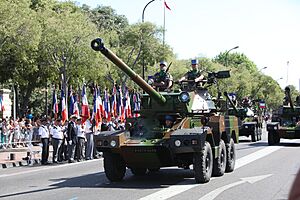
Marseille has a special culture that makes it stand out in France. It is a major center for culture and entertainment. The city has an important opera house, museums about history and the sea, five art galleries, and many cinemas, clubs, bars, and restaurants.
Marseille has many theaters, like La Criée and Le Gymnase. There is also a large arts centre called La Friche. The Alcazar, once a famous music hall, is now the central city library. Other music places include Le Silo and GRIM.
Many famous French writers and poets were born or lived in Marseille. These include Edmond Rostand. The small port of l'Estaque was a favorite spot for artists. Famous painters like Paul Cézanne and Georges Braque spent time there.
A City of Many Cultures
Marseille is known for its multicultural tolerance. Different neighborhoods, rich and poor, exist side by side. People from various backgrounds share a unique Marseille identity. For example, in 2005, when there were riots in other French cities, Marseille remained calm.
Marseille was the European Capital of Culture in 2013. This event celebrated cultural diversity and helped people from different European countries understand each other better. Over 900 cultural events took place, attracting more than 11 million visitors. New cultural buildings, like the MuCEM, were also opened.
Immigrants have always been a part of Marseille. In the early 1900s, it was one of Europe's busiest ports. People from all around the Mediterranean arrived here. This continued after World War II, with waves of Jewish immigrants from North Africa and French citizens from Algeria.
You can see Marseille's diverse culture at the Noailles market. It's also called Marché des Capucins. Here, you'll find Lebanese bakeries, African spice markets, and Chinese and Vietnamese groceries. You can also buy fresh fish and clothes from around the Mediterranean.
Armenians have had a long history in Marseille. They had a large trading network and traded a lot with Marseille's port. They even gained special trading rights in France in the 1600s. This helped Armenians become very successful in the city.
Tarot and Santons: Local Traditions
The most common tarot card deck is named after the city. It has been called the Tarot de Marseille since the 1930s. Before that, it was just called Tarot. It was used for games before it became popular for fortune-telling.
Another local tradition is making santons. These are small, handmade figures used in traditional Christmas scenes. Since 1803, there has been a Santon Fair in Marseille every year. It starts on the last Sunday of November.
Opera and Ballet
Marseille's main cultural attraction for a long time was its Opera. It was built in the late 1700s. In 1919, a fire almost destroyed it. Only the front columns were left. The opera house was rebuilt in a modern style called Art Deco. Today, the Opéra de Marseille puts on six or seven operas each year.
The Ballet national de Marseille has performed at the opera house since 1972.
Popular Events and Festivals
Marseille hosts many popular festivals. These often include concerts, fun activities, and outdoor bars. One example is the Fête du Panier in June. On June 21st, there are dozens of free concerts across the city for France's Fête de la Musique.
Marseille also hosts a Gay Pride event in early July. In 2013, it hosted Europride, a big international LGBT event. In late September, the electronic music festival Marsatac takes place. In October, the Fiesta des Suds offers many world music concerts.
Marseille's Hip Hop Music Scene
Marseille is well known in France for its hip hop music. Famous bands like IAM started in Marseille. Other popular groups include Fonky Family and Psy 4 de la Rime. Ragga music is also popular, with groups like Massilia Sound System.
Delicious Marseille Food
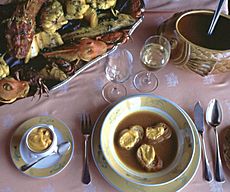
Marseille is famous for its delicious food. Here are some traditional dishes:
- Bouillabaisse: This is Marseille's most famous seafood dish. It's a fish stew with at least three kinds of fresh local fish. It often includes shellfish, potatoes, and other vegetables. The fish is usually served separately from the broth. The broth is eaten with rouille, a special mayonnaise, on toasted bread.
- Aïoli: A sauce made from raw garlic, lemon juice, eggs, and olive oil. It's served with boiled fish, hard-boiled eggs, and cooked vegetables.
- Anchoïade: A paste made from anchovies, garlic, and olive oil. It's spread on bread or served with raw vegetables.
- Bourride: A soup made with white fish and aïoli.
- Fougasse: A flat Provençal bread, similar to Italian focaccia. It's sometimes filled with olives, cheese, or anchovies.
- Navette de Marseille: Small, boat-shaped cookies that taste a bit like orange peel.
- Panisse: Made from chickpea flour, boiled into a thick paste, then cut into blocks and fried.
- Pastis: An alcoholic drink with aniseed and spice. It's very popular in the region.
- Pieds paquets: A dish made from sheep's feet and other parts.
- Pistou: A mix of crushed fresh basil, garlic, and olive oil. It's like Italian pesto. "Soupe au pistou" is a soup with pistou, pasta, and vegetables.
- Tapenade: A paste made from chopped olives, capers, and olive oil. Sometimes anchovies are added.
Must-See Sights in Marseille
Marseille is known as a major center of art and history. The city has many museums, galleries, and old buildings and churches.
Exploring Central Marseille
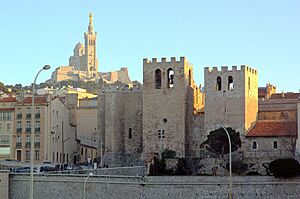
Most of Marseille's attractions are in the central areas. These include:
- The Old Port or Vieux-Port: The city's main harbor and marina. It's guarded by two large forts. Many cafes line the waterfront. The Quai des Belges has a daily fish market.
- The Hôtel de Ville (City Hall): A beautiful 17th-century building.
- The Centre Bourse and Rue St Ferreol: The main shopping areas in central Marseille.
- The Porte d'Aix: A triumphal arch celebrating French victories.
- The Hôtel-Dieu: A former hospital in Le Panier, now a luxury hotel.
- La Vieille Charité in Le Panier: An impressive building with a central chapel. It now holds an archeological museum and an art gallery.
- The Cathedral of Sainte-Marie-Majeure or La Major: A huge church rebuilt in the 1800s in a Romano-Byzantine style.
- The 12th-century church of Saint-Laurent: Located near the cathedral.
- The Abbey of Saint-Victor: One of Europe's oldest Christian worship sites. Its ancient crypt and catacombs were used for Christian martyrs.
Marseille's Museums
Marseille has many interesting museums:
- The Musée des Civilisations de l'Europe et de la Méditerranée (MuCEM): Opened in 2013, it focuses on the history and culture of European and Mediterranean civilizations.
- The Musée Regards de Provence: Also opened in 2013, it shows historical artworks from Provence.
- The Musée du Vieux Marseille: Located in the 16th-century Maison Diamantée, it shows daily life in Marseille from the 1700s.
- The Musée des Docks Romains: Preserves remains of Roman warehouses and displays ancient objects found in the area.
- The Marseille History Museum: Located in the Centre Bourse, it tells the story of the city. It has parts of the Greek and Roman history of Marseille.
- The Musée Cantini: A modern art museum with artworks linked to Marseille, including some by Picasso.
- The Musée Grobet-Labadié: Across from the Palais Longchamp, it has a collection of European art and old musical instruments.
- The Palais Longchamp: A grand 19th-century building with a huge fountain. It houses the Musée des beaux-arts de Marseille (fine arts museum) and the Natural History Museum.
- The Château Borély: Located in the Parc Borély, it houses the Museum of the Decorative Arts, Fashion and Ceramics.
- The Musée d'Art Contemporain de Marseille (MAC): Opened in 1994, it shows American and European art from the 1960s to today.
- The Musée du Terroir Marseillais: In Château-Gombert, it focuses on Provençal crafts and traditions.
Attractions Beyond the City Center
Outside the city center, you can visit:
- The Basilica of Notre-Dame de la Garde: A large 19th-century church on a hill south of the Old Port. It offers amazing views of Marseille.
- The Stade Vélodrome: The home stadium of the Olympique de Marseille football team.
- The Unité d'Habitation: A famous modern building designed by Le Corbusier in 1952.
- The Docks de Marseille: Old warehouses from the 1800s that are now offices.
- The Pharo Gardens: A park with views of the Mediterranean Sea and the Old Port.
- The Corniche: A road along the waterfront with beautiful views.
- The beaches: Including Prado, Pointe Rouge, and Les Goudes.
- The Calanques: A mountainous coastal area that is now Calanques National Park.
- The islands of the Frioul archipelago: You can take a ferry from the Old Port to visit them. The prison of Château d'If is on one of these islands.
Learning in Marseille: Education
Marseille is home to several parts of the Aix-Marseille University. This includes:
- University of Provence
- Université de la Méditerranée Aix-Marseille II
- Université Paul Cézanne Aix-Marseille III
The city also has four important engineering and business schools:
- Ecole Centrale de Marseille
- École pour l'informatique et les nouvelles technologies
- Institut polytechnique des sciences avancées
- KEDGE Business School
Many major French research groups have offices in Marseille. Scientific research is done at several locations. These include Luminy, which has institutes for biology and marine sciences. The Timone hospital site is known for medical research. Marseille is also the headquarters of the IRD, which supports research for developing countries.
Getting Around Marseille: Transport
Travel to and from Marseille
Marseille has an international airport, Marseille Provence Airport, located in Marignane. It is the fifth busiest airport in France. A large network of motorways connects Marseille to other cities.
Gare de Marseille Saint-Charles is Marseille's main train station. You can take regional trains to nearby cities. It is also a major station for the TGV (high-speed train). You can reach Paris from Marseille in just three hours by TGV. There are also direct TGV lines to other European cities like Brussels and Geneva.
A new long-distance bus station is next to the Gare Saint-Charles. It has buses to towns in the Bouches-du-Rhône area. Marseille also has a large ferry terminal, the Gare Maritime. From here, you can take ferries to Corsica, Sardinia, Algeria, and Tunisia.
Public Transport in the City
Marseille has a Métro (subway) system run by the Régie des transports de Marseille (RTM). It has two lines that cross at Gare Saint-Charles. The Métro uses a turnstile system, and you buy tickets at automated booths.
The city also has a large bus network with many lines. A tramway system opened in 2007. It has three lines.
Marseille offers a bike-sharing service called "Le vélo." It's free for trips shorter than half an hour. A free ferry service operates across the Old Port. You can also take ferry shuttles from the Old Port to other areas like Pointe Rouge and l'Estaque. Boat trips are available to the Frioul archipelago and the Calanques.
Sports in Marseille
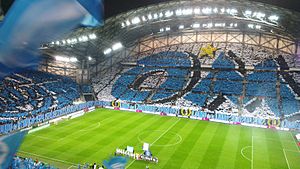
Marseille has many sports facilities and teams. The most popular team is the city's football club, Olympique de Marseille. They won the UEFA Champions League in 1993, which is a big achievement for a French club. They were also finalists in the UEFA Europa League several times.
The club's home stadium is the Stade Vélodrome. It can hold about 67,000 people. This stadium also hosts other local sports and matches for the national rugby team. It has hosted games for the 1998 FIFA World Cup, 2007 Rugby World Cup, and UEFA Euro 2016.
Marseille is famous for pétanque, a game similar to bocce. It's even called the pétanque capitale. The city hosts the Mondial la Marseillaise de pétanque every year, which is a major competition.
Sailing is a big sport in Marseille. The city's warm waters and windy conditions are perfect for regattas (sailing races). Marseille has hosted many Match Race France events, which bring the world's best sailing teams. These races are exciting to watch because they happen close to the shore.
CN Marseille is one of France's top Water polo teams. They have won the national championship many times. Marseille is also a great place for other water sports like windsurfing and powerboating. The city has several golf courses and public swimming pools. Running is popular in parks like Le Pharo. An annual footrace, the Marseille-Cassis Classique Internationale, is held between Marseille and Cassis.
Famous People from Marseille
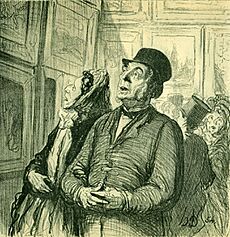
Many notable people were born in Marseille, including:
- Pytheas (around 300s BC), a Greek merchant and explorer.
- Désirée Clary (1777–1860), who became Queen of Sweden.
- Adolphe Thiers (1797–1877), the first president of the Third Republic.
- Honoré Daumier (1808–1879), a famous caricaturist and painter.
- Marius Petipa (1818–1910), a famous ballet dancer and choreographer.
- Edmond Rostand (1868–1918), a poet and playwright.
- Henri Fabre (1882–1984), who invented the first seaplane.
- Darius Milhaud (1892–1974), a well-known composer.
- Fernandel (1903–1971), a popular actor.
- Maurice Béjart (1927–2007), a famous ballet choreographer.
- Eric Cantona (born 1966), a legendary football player for Manchester United and the French national team.
- Zinedine Zidane (born 1972), a world-famous football player and former captain of the French national team.
- Jessica Fox (born 1994), a French-born Australian world and Olympic champion in slalom canoeing.
- Lucas Hernandez (born 1996), a football player.
- Théo Hernandez (born 1997), a football player.
Marseille's Global Connections
Sister Cities Around the World
Marseille has "sister city" relationships with 14 cities. Most of these are port cities, except for Marrakech. These connections help build friendships and cultural exchange between cities.
 Abidjan, Ivory Coast (1958)
Abidjan, Ivory Coast (1958) Antwerp, Belgium (1958)
Antwerp, Belgium (1958) Copenhagen, Denmark (1958)
Copenhagen, Denmark (1958) Dakar, Senegal (1968)
Dakar, Senegal (1968) Genoa, Italy (1958)
Genoa, Italy (1958) Glasgow, United Kingdom (2006)
Glasgow, United Kingdom (2006) Haifa, Israel (1958)
Haifa, Israel (1958) Hamburg, Germany (1958)
Hamburg, Germany (1958) Kobe, Japan (1961)
Kobe, Japan (1961) Marrakech, Morocco (2004)
Marrakech, Morocco (2004) Odesa, Ukraine (1972)
Odesa, Ukraine (1972) Piraeus, Greece (1984)
Piraeus, Greece (1984) Shanghai, China (1987)
Shanghai, China (1987) Tunis, Tunisia (1989)
Tunis, Tunisia (1989)
Partner Cities for Cooperation
Marseille also has cooperation agreements with 21 other cities worldwide. These agreements help with cultural and economic exchanges.
 Agadir, Morocco (2003)
Agadir, Morocco (2003) Alexandria, Egypt (1991)
Alexandria, Egypt (1991) Algiers, Algeria (1980)
Algiers, Algeria (1980) Bamako, Mali (1991)
Bamako, Mali (1991) Barcelona, Spain (1998)
Barcelona, Spain (1998) Beirut, Lebanon (2003)
Beirut, Lebanon (2003) Casablanca, Morocco (1998)
Casablanca, Morocco (1998) Istanbul, Turkey (2003)
Istanbul, Turkey (2003) Lomé, Togo(1995)
Lomé, Togo(1995) Lyon, France
Lyon, France Jerusalem(2006)
Jerusalem(2006) Montevideo, Uruguay (1999)
Montevideo, Uruguay (1999) Thessaloniki, Greece
Thessaloniki, Greece Saint Petersburg, Russia (2013)
Saint Petersburg, Russia (2013) Meknes, Morocco (1998)
Meknes, Morocco (1998) Rabat, Morocco (1989)
Rabat, Morocco (1989) Tirana, Albania (1991)
Tirana, Albania (1991) Tripoli, Libya (1991)
Tripoli, Libya (1991) Tunis, Tunisia (1998)
Tunis, Tunisia (1998) Varna, Bulgaria (2007)
Varna, Bulgaria (2007) Yerevan, Armenia (1992)
Yerevan, Armenia (1992)
Images for kids
-
A silver drachma inscribed with MASSA[LIA] (ΜΑΣΣΑ[ΛΙΑ]), dated 375–200 BC, during the Hellenistic period of Marseille, bearing the head of the Greek goddess Artemis on the obverse and a lion on the reverse
-
Gaston Defferre served as Mayor of Marseille from 1953 to 1986.
-
Paul Cézanne's The Bay of Marseille, Seen from L'Estaque
-
Bastille Day military parade in Marseille, 2012
-
Traditional Marseille bouillabaisse
-
Swordfish in olive oil with ratatouille and saffron rice
-
The Abbey of St. Victor and the basilica of Notre-Dame de la Garde
-
The Stade Vélodrome, home of Olympique de Marseille
-
Honoré Daumier: Sunday at the Museum
See also
 In Spanish: Marsella para niños
In Spanish: Marsella para niños


